The 2018 Insect Fear Film Festival Helps Visitors Combat Fears and Entomophobias
Feburary 26, 2018
We're not going to force anyone to fall in love with any insect; we just want them to be informed.” – Entomology PhD student Charles Dean
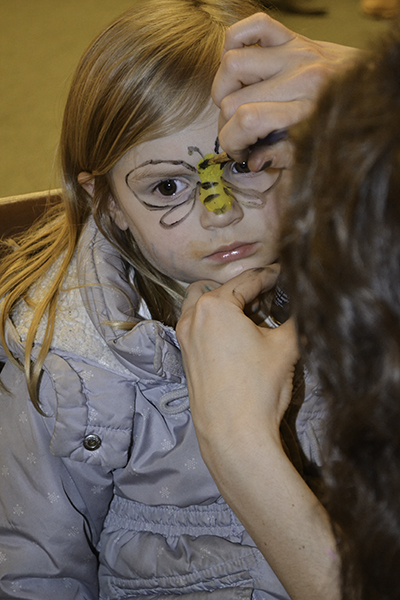
A young visitor to the IFFF gets her face painted with a honeybee.
Got a kid who is fascinated with insects? Conversely, got a kid who has a panic attack every time he or she even sees a bug? (Or, let’s get real, are you yourself perhaps a bit leery of them?) Do you love mocking really bad, really cheesy films—in this case, B horror flicks about insects? Folks who could answer “Yes!” to one or more of the above questions showed up at Foellinger Auditorium on Saturday, February 24th for the 35th Annual Insect Fear Film Festival (IFFF). Hosted by the EGSA (Entomology Graduate Student Organization), the festival not only exposed the around 500+ visitors to films about insects. Through both fun and educational activities, it possibly helped them overcome some unfounded fears and/or learn how to nurture “good” insects. And hopefully, participants left a bit more knowledgeable about insects in general…and about the star of the show, the Tick.
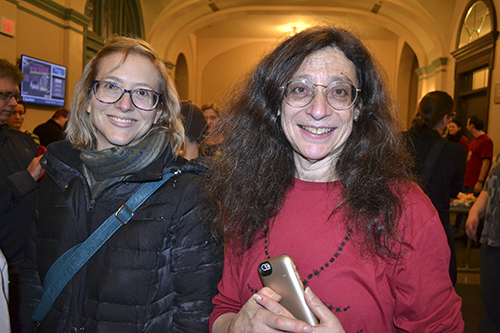
Creater of the Insect Fear Film Festival, Professor May Barenbaum (right) and Integrative Biology Professor Katy Heath.
The Festival was begun in 1984 by Entomology Department Head, Professor May Berenbaum, with some help from her husband, a professor who also happened to be a film buff who knew movies. Billed as “Scaring the general public with horrific films and horrific filmmaking since 1984,” the 2018 IFFF did not disappoint.
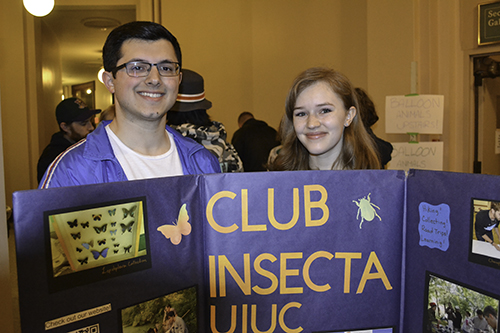
Two entomology undergraduate students, Lorenzo D'Alessio and Laura Whipple, who helped with the Club Insecta exhibit.
Why was the IFFF begun? According to entomology PhD student and EGSA president Charles Dean, “There is this phobia of insects that is pervasive throughout society. And with that comes a fear that they might be bad or dangerous for you. While that's true sometimes, it's not always true.”
Dean, who’s studying the co-evolutionary relationship between wild parsnip and parsnip web worms in Berenbaum’s lab, says the idea behind the IFFF was to use movies—both B quality movies and funny ones—to “undercut the phobia and start a dialogue within the community about what insects do and how they affect your life. Over the years, it has really become sort of a communal gathering point in Champaign-Urbana,” he adds, “and we're really proud of it.”
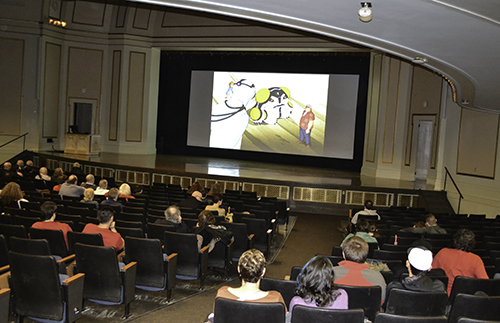
Some visitors to the Festival catch the first short: Ben 10: The Big Tick.
The films for the 2018 edition of the festival featured, of course, the insect of the hour—the lowly tick. One of the shorts, billed as “family friendly,” included Ben10: The Big Tick, an animated TV series episode about an enormous tick-like alien bent on destroying Earth. In the second, Soldiers of Fortune: Bite of the Ruby Red, a scientist searches for a cure for a deadly tick-borne fever in Central America. The feature film (not quite so family-friendly), Ticks, was about a group of teenagers on a wilderness retreat who encountered super-sized ticks mutated by agricultural runoff from an illegal marijuana-growing operation.
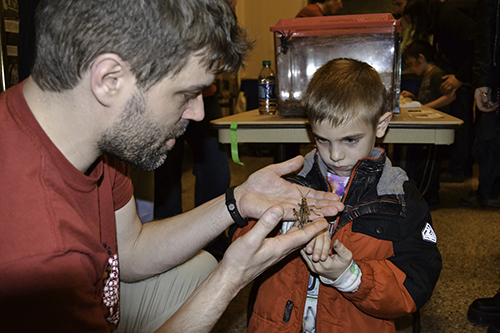
An Entomology graduate student, Jared Thomas, gives a local youngster a huge grasshopper to hold.
While the tongue-in-cheek implication inherent in the Festival’s title was that some of the films—or the insects starring in them—might make your hair stand on end, it was the intent of the planners that via closer proximity and education, participants might even get over their entomophobia (defined as “excessive or unrealistic fear of one or more classes of insects,” by Wikipedia, which lists a raft of them, including apiphobia (fear of bees), myrmecophobia (fear of ants) and mottephobia (fear of moths or butterflies). A quick Google search reports that an overly anxious fear of ticks is entonophobia.
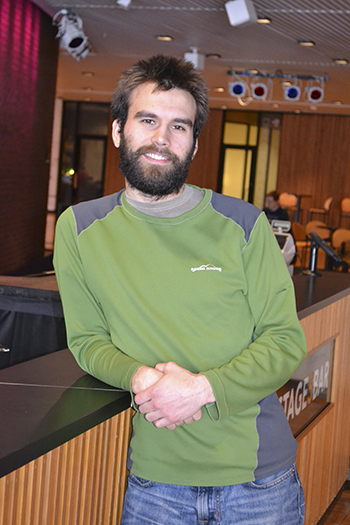
EGSA Outreach Coordinator Jacob Dixon.
EGSA’s Outreach Coordinator, Jacob Dixon, who also works in Berenbaum’s lab studying navel orange worms, claims that exposing people to insects is really important in order to help them overcome unfounded fears. “A lot of times when people are scared of insects, they never go out and try to look for them, and when they run into them they get scared.”
Dixon stresses that EGSA's outreach activities are designed to help people slowly get comfortable with insects through controlled exposure and education. “A lot of times, outreach is really aimed at "Here's an insect. I'm holding it. You don't have to touch it." He adds that further communication with people about a given insect can slowly alleviate a person’s fears.
“’They're not harmful,’ he continues. ‘They might be a little fast and spooky.’ But it helps people get comfortable with insects. And then you can have a conversation saying, ‘They don't bite, and they aren't poisonous. But these ones are, but they're not going to jump at you!’ Through that, people get more comfortable and understand them more.”

A brave student holds a tarantula at the petting zoo. (image courtesy of Kristina Allen)
But the Festival was a whole lot more than just a mock-fest (or therapy session) featuring really scary (or really bad) films about insects. It was also a unique STEM education opportunity to learn about insects.
For instance, one of the most popular events at IFFF was an opportunity designed to help youngsters (and adults!) overcome their fear of insects: EGSA’s famous Petting Zoo. Visitors large and small got to pet, hold, and examine up close tarantulas, beetles, and other insects & arthropods.
Plus, to get the scoop on ticks, visitors could stop by the info booth to learn all about them, such as how to identify ticks by observing them up close (though separated by a layer of plastic!). Plus, handouts explained the tick's life cycle, showed where ticks live, and taught visitors how to stay safe when outside. A couple of pamphlets included the catchy, "Don't Let a Tick Make You sick!" slogan. Visitors also learned what to do if bitten by a tick and how to identify the early signs of Rocky Mountain Spotted Fever and another disease spread by ticks, Lyme Disease.
According to Dean, while Rocky Mountain Spotted Fever was historically a big concern, “The big one that we are on the lookout for these days is Lyme Disease. Lyme disease has the characteristic bullseye rash that you have to spot right away, because the other symptoms that come along after that can be mistaken for a fever, but by the time you get those, it's too late.” Although Lyme Disease is not fatal, Dean reports, “It's not fun.”
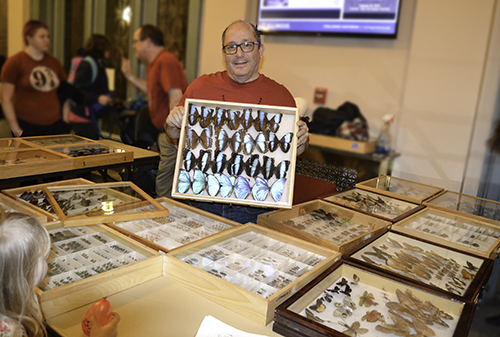
Dr. Nathan Schiff of the USDA Forest Service shows just a small portion of his insect collection.
Dr. Nathan Schiff, an Illinois Entomology alumnus now with the USDA Forest Service, made his annual trek back to his alma mater for the IFFF. He brought with him just a small part of his huge collection of more than 300 specimens which he has gathered from more than 30 different countries. The numerous glass cases showcased unique and colorful butterfiles, moths, and other insects.

A young visitor proudly poses with the drawing he made as part of the art contest.
One activity featured during the Festival, which, Dixon calls, “pretty cool!” was the IFFF Art Contest featuring tick-themed artwork submitted by local K–12 students. According to Dean, because it’s for a broad age group, students’ contributions were divided into different categories based on age—lest kindergarteners become dismayed over being beat out by a high schooler—or vice versa. For the judging, a "tribunal of graduate students" voted for their favorites. Then at the IFFF, Berenbaum announced the winners and gave out awards.
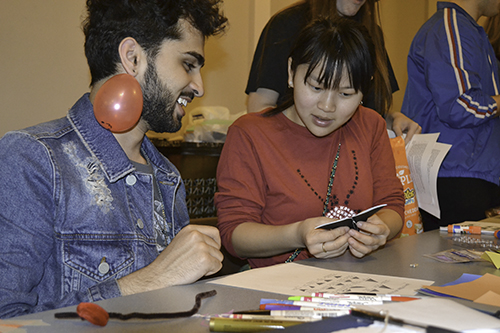
Club Insecta members Wyed Ali and Liz Dabek provided hands-on activities for young visitors, such as origami and pipe-cleaner insects
For families with small children, there were also loads of other fun, insect-related activities.
Club Insecta, a club for Entomology undergrads, staffed a table with a number of hands-on activities. Kids could make origami insects, an insect made of pipe cleaners, and received a red balloon "Lone Star Tick," complete with a star.
To liven things up, May’s daughter, a ventriloquist, made an appearance, and she and her Lone Star Tick puppet played Tic Tac Toe with youngsters, who, mysteriously, always won.

Above: Entomology graduate student Erin Allmann Updyke paints the face of a local fourth grader.
Below: The finished product: a ladybug.
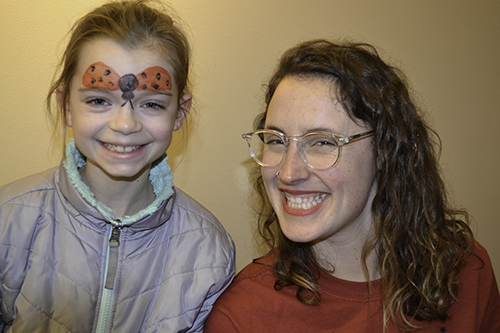
Plus, a team of entomology grad students was on hand to create insect-shaped balloon sculptures. Youngsters could choose between a butterfly, a ladybug, a honeybee, and a tick.) Kids could also get their faces painted with their favorite insect friend.
And to remember the event, plus help fund the event, Visitors could purchase IFFF t-shirts, and for the kiddies, there were also stickers of their favorite (or most feared) insects.
The goal of the EGSA and Entomology in doing the Festival and other outreach activities, is to integrate themselves into the community. In fact, they do a lot more than host the insect film festival every year. They have a farmer's market booth every year during Pollinator Week. Dean even reports that he’s even gone to people's homes and gotten rid of their wasp nests for them.
One of EGSA’s most important outreach activities is to visit schools. According to Dixon, the group’s Outreach Coordinator, they have a long-standing partnership with many of the local schools they’ve visited in the past. During the busy months, they could have multiple outreach events in a week. However, during the winter it's pretty slow. The group has also been fairly regular visitors at the Orpheum Children’s Science Museum.
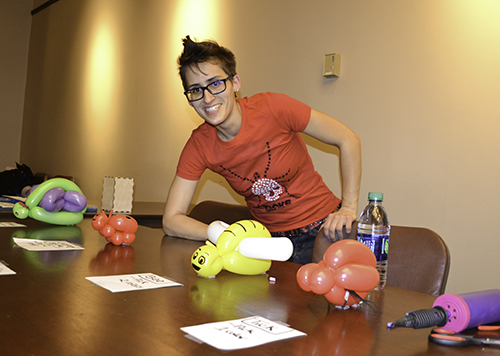
Entomology graduate student Tanya Josek helping out at the balloon insects station shows the balloon insects kids could have made for themselves—all of which she designed (from left to right: a butterfly, a ladybug, a honeybee, and a tick.)
What’s their message during these various outreach events? They talk to participants about insects, telling them what to do about certain insect pests, along with another important part of their message—underscoring that there’s also a good side to insects. Take pollinators, for example. They strive to communicate to not just kids, but the public, why everyone should care about the honey bee decline and the bumble bee decline. They also stress the importance of insects as decomposers, and their work in helping to make compost.
Why is engaging with the community, especially schools, so important? Dean shares the importance of outreach to schools, particularly for the specific age groups.
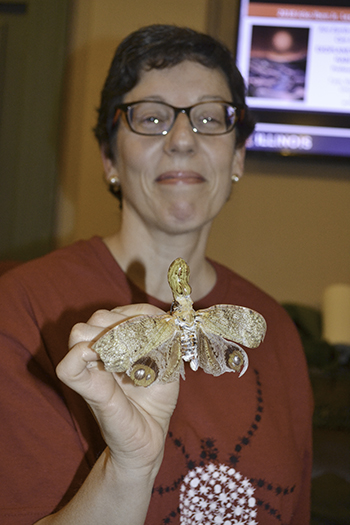
An Illinois Entomology alumna Dr. Ellen Green, who returns every year for the Festival shows off a flashy moth from Nathan Schiff's collection.
“Basically, we want to not only produce good research in this department, but we want to also be a part of the surrounding community,” Dean asserts. “We want to have an immediate effect on people's lives around us. We'd rather not exist behind closed doors.”
Like the IFFF, some of the EGSA’s other more popular events have also been film related. For instance, when they hosted the creator of the X-File, who had used a lot of May's work for inspiration for his movies and TV shows, upwards of 1000 people showed up for the event, which included a Q & A with the audience. Also, in 2017, they invited a producer and director who had worked on several insect-themed horror movies, like Mongolian Death Worm and Lava-Lantula. “All the classics,” Dean boasts.
Besides outreach, the EGSA also organizes support activities for the around 35-40 Entomology grad students who comprise the organization, such as arranging transportation to different conferences. For instance, last fall they traveled to Denver for the National Entomology Association meeting. The EGSA also organizes social events for the grad students, like bowling and camping.
Of course, they consider community outreach to be one of their most important activities.

Two young visitors show off the balloon butterflies they got at the IFFF.
“When doing an outreach at a school for kindergartners through second grade,” Dean explains, “that is their earliest introduction to insects. So what insects are, what they do, which ones to avoid, and what you can do to help the ones we like—like the bees and butterflies that stop by your garden.”
They also bring younger students, such as second graders, on field trips to the Pollinatarium. “So they can see honey bee colonies,” Dean explains. “They can see different insects around a preserved prairie stand.”
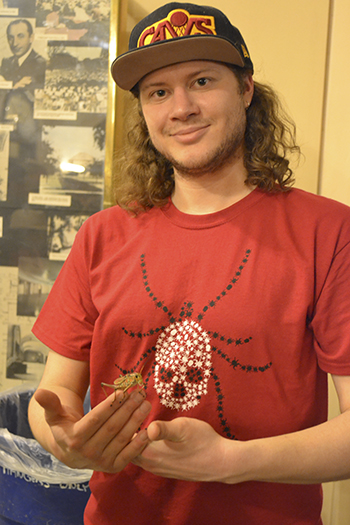
Entomology PhD student and EGSA president Charles Dean holds a grasshopper. (image courtesy of Kristina Allen)
Dean indicates that their goal regarding outreach to high schoolers and young adults is more career related. “A lot of times it’s introducing the idea, but if the idea's already there among them, it's nurturing this idea that this is a really cool career path if that's your choice,” Dean says.
He goes on to share some of the benefits of a career in Entomology. “If you want to be involved in the sciences, and you like doing research (which I compare to solving natural puzzles for a living), and you want things like intellectual autonomy, and you want to contribute to a growing base of knowledge, then you can make a career out of that childhood hobby that your parents hated.”
And Dean speaks from personal experience about part where the parents hate a youngster’s infatuation with insects. “I was bringing insects in the house, and my parents were not thrilled,” he admits. “But eventually they were happy about it once they learned I could make a career out of it. And if people are interested, we'd like to sort of nurture that. And if people are fearful of it, we at least want them to be informed.”
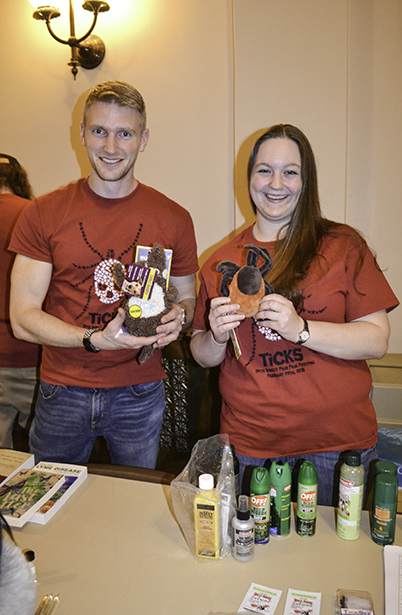
Entomology grad student Jonathan Tetlie (left) and a student visiting for recruitment week staffing the info table, which contained books, pamphlets, insecticides, even insect-related toys.
Regarding careers for entomologists, Dean adds that grad students that come out of their department can either continue on in academia, become teachers, or work in natural history museums or national labs.
“The field of entomological research has been the basis of many influential scientific discoveries,” he boasts. “They're a model system, and easy to maintain, easy to work with. They have a shorter generation time than other animals.”
In addition to informing the general public about what they can do to help pollinators or decomposers, and to avoid things like bed bugs and ticks, “We also want to inform them about what it is that we do, and how we are trying to make an impact on the scientific community,” he adds.
Regarding the IFFF, Dean admits, “We love interacting with the people around us, and we want to continue being a part of the community. This is hopefully as much fun for them as it is for us.
Story and photographs by Elizabeth Innes unless otherwise noted, Communications Specialist, I-STEM Education Initiative.
More: Entomology, 2018
For additional I-STEM web articles about Illinois' Entomology outreach, see:
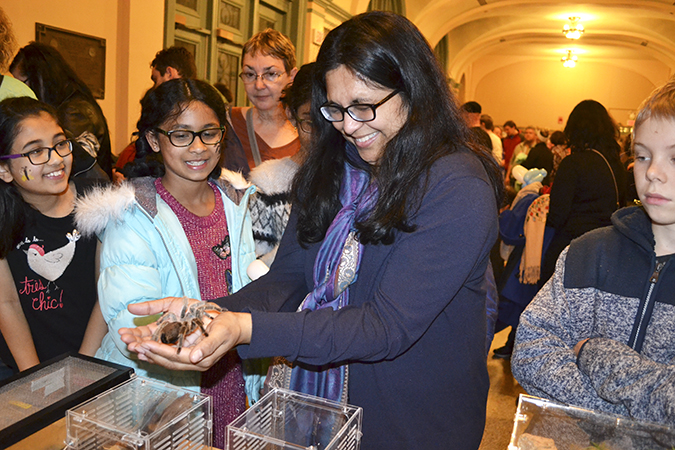
A mother overcomes her fears and holds a tarantula at the EGSA petting zoo.
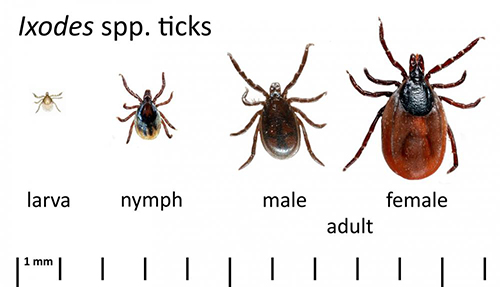













.jpg)
















